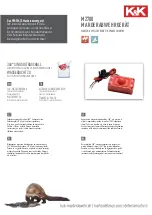
Double isolation and bleed DIB-1 (both seats bi-directional)
Double sealing established on each seat bi-directionally by initial plastic-to metal contact in addition to
metal-to-metal contact, both upstream, downstream and body cavity. In the closed position, the gate
forms a tight seal simultaneously on both seats bi-directionally. This allows the body cavity to be
manually bled. An automatic cavity pressure relief device is provided to relieve the build-up of over
pressure in the body cavity.
Mechanically induced bubble tight seal
When closing, the segment is positioned by a mechanical stop while the gate continues going downward,
expanding the segment and gate against their opposite seats. This action forms a bubble tight seal on
both the upstream and downstream seat to reach a double isolation sealing function.
Wear and tear reduction
When the valve is completely closed, the gate and segment are wedged tightly against each seat. During
operation, the gate and segment retract from the seats prior to stroking; this retraction provides an
operating clearance to reduce rubbing of the resilient seat material and protects the sealing surfaces.
Additionally this reduces the operating torque and allows a smaller and more economical operator for
smooth operation.
Lever lock mechanism - Size 150NB (6”) and above
The lever arm maintains the gate & segment surfaces parallel by guide plates,
while the expanding gate assembly is moving through its stroke. Near the end of
stroke, the guide plate allows the lever arm to tilt. The gate and segment slide
against their angled faces under stem provided thrust force, creating the
expanding seal action. In their final position, the gate and segment are
mechanically secured in place. The guide plates forms a rail at both sides of the
expanding gate assembly to guide its movements and align it with the seats.
Australian Pipeline Valve - Installation, Operation and Maintenance Manual
26
API6D THROUGH CONDUIT EXPANDING GATE VALVE - AP400-405 SERIES
In the fully closed position, the
segment is positioned by the
mechanical stop and the gate is
wedged downward under stem thrust
force, expanding the segment and
gate to form a tight seal on each seat
bi-directionally between upstream
and downstream.
During travel between fully open or
close position, the gate and segment
retract from the seats prior to travel;
this retraction provides an operating
clearance to reduce wear on the
sealing surface and operating torque.
When the bore of the segment is
aligned with the body bore, the
segment is positioned by the
mechanical stop and the gate
continues to move upwards, expanding
the gate and the segment to form a
through conduit bore and protect the
sealing surface from flow erosion.









































